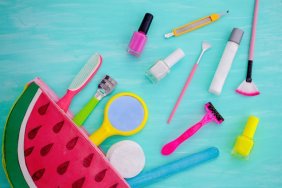Late nights and early mornings are associated with the daily grind. Then there is the unsexy aftereffect of tired, puffy eyes. Think lack of sleep is the only culprit? Think again. “With aging a piece of tissue located under the eyes called the septum becomes thin. Normal fat pads located beneath the septum can then herniate (break through) causing a bulge under the eyes,” explains consulting dermatologist for Clark’s Botanicals Dr. Donna Bilu Martin.
Diet is clearly a key player in bags under eyes and excessive puffiness. Avoiding salty foods or checking the labels on processed foods will definitely save you grief later. If you overdo it with seasoning (or even alcohol), rehydrate with water before bed. Plus, let’s not forget the thin, delicate skin area can be damaged by sun exposure. Not to mention environmental toxins (like smoking), which lead to excess sagging and wrinkling.
“Eye puffiness is the result of an excessive amount of fluid retention in the connective tissue surrounding the eyes,” explains dermatologist Dr. Patricia Wexler. “We most commonly deal with the weakened ligaments that hold the fat back and eventually let the fat fall forward and bulge. The bags under eyes become more prominent when circulation is stagnant while sleeping and become fluid overloaded.”

Image: Imaxtree
Obviously, the first reflex is to reach for an eye cream. Although finding products that actually stimulate collagen (the plumping factor) and incorporating a daily sunscreen are also key. Board-certified dermatologist and medical director of Dermstore.com Dr. Ashley Magovern is a fan of products that contain vitamin C (like tetrahexyldecyl ascorbate). Or ones with niacinamide (vitamin B3) and peptides.
“As your undereye area gets stronger, if you can add in a product that contains a retinoid, that’s ideal,” adds Magovern. “Ceramides are one of the best ways to maintain your skin barrier and using a ceramide-dominant moisturizing product is great (can use all over your face, but include the eye area). This will help prevent any inflammation and irritation and allow you to be more successful in using the more active ingredients, which can sometimes cause some inflammation.”
How much sleep you need varies from person to person. If you aren’t catching enough, your eyes can look dull, red and unavoidably puffy. “Healthy sleep habits can go a long way when it comes to both undereye puffiness and dark circles,” adds Magovern, “This will work better than any eye cream.” Try propping an extra pillow (or two) under your head. This prevents the liquid from storing up overnight causing fluid to drain downward.

Image: Imaxtree
“If you have dark undereye circles and/or are hollow, you can use light-reflecting makeup and highlighters underneath your eyes,” advises Dr. Jason B. Diamond, facial plastic surgeon. Use eye drops to help whiten your eyes. An all-power concealer helps disguise dark circles. In addition, color-correcting formulas can be custom blended to disguise imperfections. Final touches, like hints of highlights (on the brow bone) along with lush curled lashes, really make your eyes pop.
Also, don’t underestimate at-home hacks. Like tried-and-true cucumber slices. Or caffeinated tea bags. “It is absolutely helpful to use [these] DIY remedies,” explains Wexler. “Both decrease fluid within the fat, green tea [bags] can also decrease inflammation.”
Seeking a more permanent solution for how to get rid of bags under eyes? There are definitely things to consider. Make sure you choose a surgeon who is board certified and fellowship trained in the surgery that will be performed. “It can be confusing as there as some physicians performing cosmetic surgeries who may not have the same training and certifications as others,” explains Magovern. “It’s always a good idea to get a few consultations.”
According to Diamond: “Different surgical procedures address each problem and it is important to have a thorough understanding of which problem one has so that the most appropriate and effective method can be performed. If not, the problems can worsen.”






